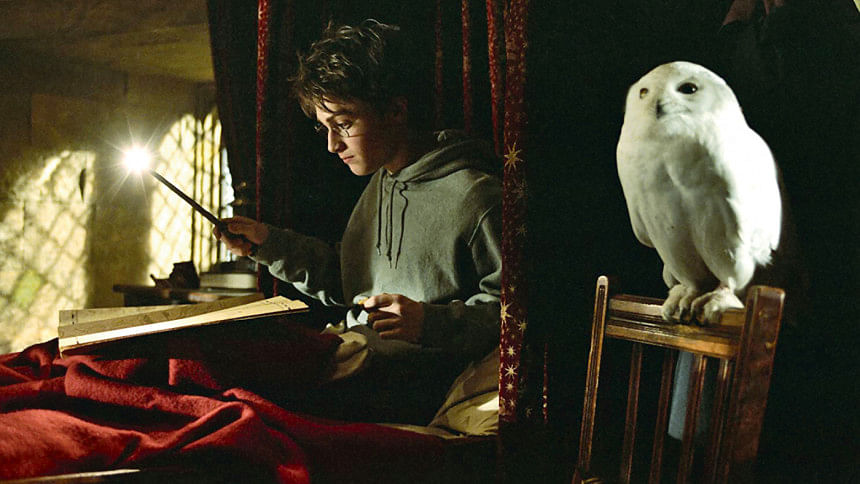What makes The Prisoner of Azkaban best in the movie franchise?

We were supposed to have a Harry Potter-themed issue for this week, honouring the Hogwarts Express arrival day on September 1. When that didn't happen, I was persistent enough to have the last page for some "moderate" amount of fangirling for my most favourite Harry Potter film ever. The bossman had to give in.
There are many reasons why I would choose "Prisoner of Azkaban" as my favourite Harry Potter Book (If I absolutely have to, that is). Apart from the emotions involved with the marauders' backstory, the book takes a matured step towards the rest of the series. It changes the tone of the series by shifting from the bedtime story vibe of the first two books to a more serious one, making the readers grow with the story as well. "He-who-must-not-named" has no presence in this story whatsoever, yet the story deals with the crises of betrayal and revelation.
But the most interesting theme that this book is centred around has to be the change that comes along as the main characters start to enter adolescence. And this central theme is brilliantly portrayed in the movie adaptation. Today we talk about what an extraordinary piece of cinematic brilliance "Harry Potter and the Prisoner of Azkaban" is.
The art of adaptation
Director Alfonso Cuarón is the maker of many internationally acclaimed films, including "A Little Princess", "Y Tu Mama Tambien", "Children of Men", "Gravity" and the very recent "Roma". But what is the one thing that he did with Prisoner of Azkaban? He made it stand out on its own among the other movies of the series. How? By taking up his own aesthetic approach in dealing with the story. The film doesn't follow everything that is in the book, and while it often gets uncomforting for the readers to not have everything according to the book, that really isn't the case with this one. Cuarón and his co-writer Steve Cloves ensure that very well. And with that, Cuarón draws a fine distinction between the language of a literary work and that of a film.
Setting the tone: Visuals, colour palettes and music
The film successfully captures the essence of the book, that is the focal theme of change associated with the characters entering adolescence and a darker reality of what awaits them in the future. Cuarón introduces a darker colour palette in this film, drawing a stark contrast between the previous two films directed by Chris Columbus with the mainstream and traditional bright toning. The visuals become grim from cheerful, representing the dark energy associated with the presence of the dementors around.
Cuarón also plays a bit with the geography of Hogwarts, making it more humane and connecting the audiences more with the wizarding universe. The special effects depicting the magical creatures (For example the absolutely gorgeous Hippogriff) fit well with this setting as well. He switched up the visuals to fit well with the narrative without giving much away from the story, and that surely set a precedence for the next films of the franchise. John William's music fits beautifully with the narrative. The background score titled "A window to the past" gives me all the marauders' feels till this day.
Breaking the template: Newer techniques
Cuarón breaks the template followed by the first two films, introducing new techniques previously unseen in the franchise. He uses his signature "Long takes with no cuts" creating an element of suspense in multiple sequences and then drops the focus on one particular aspect to stress on the gravity of the moment. The most significant examples of these have to the scenes where Lupin bonds with Harry, the leaky cauldron scene and the great hall scene that includes Dumbledore and Snape. The transitions are beautifully done, intertwining suspense with comic relief.
Another aspect of the technical expertise that Cuarón shows in the film is the point-of-view shots that make you feel closer to Harry Potter as the central character of the story. The camera keeps moving with Harry, which creates a sense of unease and tension. He is also shown isolated from his best friends on multiple occasions, indicating how the future is going to be for Harry.
Time travel: Tricky business
Time travel is a difficult concept to pull off convincingly in any story, and most of the time is associated with sci-fi stories. Cuarón somehow managed to add a fresh and unique feeling the time travel bit. The presence of the giant clock throughout the film cleverly keeps indicating towards this subplot without overshadowing the story of Azkaban, and yet it is endlessly compelling no matter how many times you've seen the film.
Harry Potter and the Prisoner of Azkaban remains my favourite film of the franchise even after all these years. Why? Because "Happiness can be found even in the darkest of times when one only remembers to turn on the light", and this film surely makes me remember to turn on the light. Every time.

 For all latest news, follow The Daily Star's Google News channel.
For all latest news, follow The Daily Star's Google News channel. 



Comments